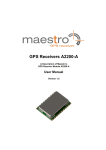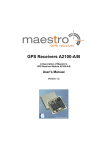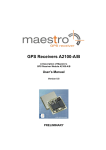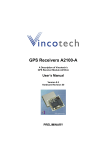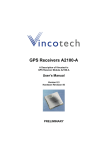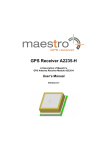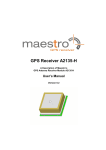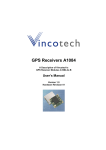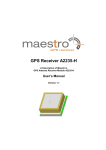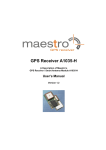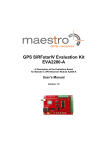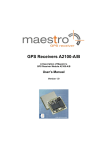Download Maestro A2200-A User manual
Transcript
GPS Receivers A2200-A A Description of Maestro’s GPS Receiver Module A2200-A User Manual Version 1.0 Revision History Rev. 0.1 1.0 Date 07-11-11 12-12-11 mm-dd-yy Description First draft, based on A2200 Updated photo ,Pin out Information,Packing Name Written by Checked by Approval by V1.0 – Feb-12 Happy wen Sam Law, Wallace Lee Frank Tang, Calvin Yau User’s Manual Date 12-12-11 12-12-11 12-12-11 Signature HW S L,W L F T,C Y Page 2 of 35 Disclaimer THIS DOCUMENT CONTAINS PROPRIETARY INFORMATION OF MAESTRO WIRELESS SOLUTIONS LIMITED. IT MAY NOT BE COPIED OR TRANSMITTED BY ANY MEANS, PASSED TO OTHERS, OR STORED IN ANY RETRIEVAL SYSTEM OR MEDIA, WITHOUT PRIOR CONSENT OF MAESTRO OR ITS AUTHORIZED AGENTS. THE INFORMATION IN THIS DOCUMENT IS, TO THE BEST OF OUR KNOWLEDGE, ENTIRELY CORRECT. HOWEVER, MAESTRO CAN NEITHER ACCEPT LIABILITY FOR ANY INACCURACIES, OR THE CONSEQUENCES THEREOF, NOR FOR ANY LIABILITY ARISING FROM THE USE OR APPLICATION OF ANY CIRCUIT, PRODUCT, OR EXAMPLE SHOWN IN THE DOCUMENT. THE PRODUCT (HARD- AND SOFTWARE) DESCRIBED IN THIS DOCUMENTATION IS NOT AUTHORIZED FOR USE IN LIFE SUPPORT DEVICES OR SYSTEMS WITHOUT THE EXPRESS WRITTEN APPROVAL OF MAESTRO. THIS DOCUMENT MAY PROVIDE LINKS TO OTHER WORLD WIDE WEB SITES OR RESOURCES. BECAUSE MAESTRO HAS NO CONTROL OVER SUCH SITES AND RESOURCES, MAESTRO SHALL NOT BE RESPONSIBLE FOR THE AVAILABILITY OF SUCH EXTERNAL SITES OR RESOURCES, AND DOES NOT ENDORSE AND IS NOT RESPONSIBLE OR LIABLE FOR ANY CONTENT, ADVERTISING, PRODUCTS, OR OTHER MATERIALS ON OR AVAILABLE FROM SUCH SITES OR RESOURCES. MAESTRO SHALL NOT BE RESPONSIBLE OR LIABLE, DIRECTLY OR INDIRECTLY, FOR ANY DAMAGE OR LOSS CAUSED OR ALLEGED TO BE CAUSED BY OR IN CONNECTION WITH USE OF OR RELIANCE ON ANY SUCH CONTENT, GOODS OR SERVICES AVAILABLE ON OR THROUGH ANY SUCH SITE OR RESOURCE. MAESTRO RESERVES THE RIGHT TO CHANGE, MODIFY, OR IMPROVE THIS DOCUMENT OR THE PRODUCT DESCRIBED HEREIN, AS SEEN FIT BY MAESTRO WITHOUT FURTHER NOTICE. V1.0 – Feb-12 User’s Manual Page 3 of 35 Table of Contents 1 Introduction ........................................................................................................ 6 1.1 Feature Overview .............................................................................................. 6 1.2 Characteristics Overview .................................................................................. 7 1.3 RoHS and Lead-Free Information ..................................................................... 7 1.4 Label ................................................................................................................. 8 1.5 Characteristics .................................................................................................. 9 1.5.1 GPS Characteristics ................................................................................................. 9 1.5.2 Mechanical Characteristics ....................................................................................... 9 1.6 Handling Precautions ........................................................................................ 9 2 Ordering Information ....................................................................................... 10 2.1 GPS Receivers A2200-A................................................................................. 10 2.2 Packing of the A2200-A .................................................................................. 10 2.3 Additional Equipment ...................................................................................... 13 3 Quick Start ........................................................................................................ 14 3.1 Minimum Configuration ................................................................................... 14 3.2 Antennas ......................................................................................................... 15 3.2.1 Passive Antennas ................................................................................................... 15 3.2.2 Active Antennas ...................................................................................................... 15 3.3 Serial Port Settings ......................................................................................... 16 3.4 Improved TTFF ............................................................................................... 16 4 Mechanical Outline .......................................................................................... 17 4.1 Details Component Side A2200-A................................................................... 17 4.2 Details Solder Side A2200-A ........................................................................... 18 5 Pin-out Information .......................................................................................... 19 5.1 Layout A2200-A .............................................................................................. 19 5.2 Description A2200-A Signals .......................................................................... 20 6 Electrical Characteristics ................................................................................ 21 6.1 Operating Conditions ...................................................................................... 21 6.2 Absolute Maximum Ratings ............................................................................ 21 6.3 DC Electrical Characteristics ........................................................................... 22 7 Mounting ........................................................................................................... 23 7.1 Proposed Footprint for Soldering .................................................................... 23 7.2 Recommended Profile for Reflow Soldering ................................................... 23 8 Use of GPS Antennas ...................................................................................... 24 8.1 Connecting a GPS antenna to the GPS receiver ............................................ 24 8.2 Antenna Connections ...................................................................................... 26 8.2.1 Passive Antennas ................................................................................................... 26 8.2.2 Active Antennas ...................................................................................................... 26 9 Quality and Reliability...................................................................................... 27 9.1 Environmental Conditions ............................................................................... 27 V1.0 – Feb-12 User’s Manual Page 4 of 35 9.2 Product Qualification ....................................................................................... 27 9.3 Production Test ............................................................................................... 27 10 Applications and Hints .................................................................................. 28 10.1 Initial Module Start ........................................................................................ 28 10.2 Proper Shutdown .......................................................................................... 28 10.3 SiRFawareTM Support ................................................................................... 28 10.4 Push-to-Fix Mode .......................................................................................... 28 10.5 Hibernate Mode............................................................................................. 29 10.6 Extended Ephemeris ..................................................................................... 29 10.7 Antenna Status Adaptation ........................................................................... 30 10.7.1 Antenna Sensor .................................................................................................... 30 10.7.2 Antenna Sensor with Current Limiter .................................................................... 31 10.8 VANT Pin ...................................................................................................... 32 11 Evaluation Kit EVA2200-A ............................................................................. 33 12 Related Information ....................................................................................... 34 12.1 Contact.......................................................................................................... 34 12.2 Related Documents....................................................................................... 34 12.3 Related Tools ................................................................................................ 34 13 List of Figures ................................................................................................ 35 14 List of Tables .................................................................................................. 35 V1.0 – Feb-12 User’s Manual Page 5 of 35 1 Introduction The GPS module A2200-A is Maestro’s first implementation of CSR’s SiRFstarIV ROM chip on GPS module. This is highly integrated GPS receivers that can be used as SMT components. A very easy implementation (power, serial, ON_OFF, and antenna) allows receiving position, velocity and time information. The A2200-A is a module designed for a 3.3V environment. 1.1 Feature Overview The A2200-A is new module with the following outstanding features. Fast, responsive location experience o High-sensitive navigation engine with tracking down to -163dBm o 48 track verification channels o SBAS (WAAS, EGNOS, MSAS, GAGAN) Breakthrough micro power technology o Requires only 50 – 500µA to maintain hot start capability Active jammer remover o Removes in-band jammers up to 80dB/Hz o Tracks up to eight CW (continuous wave) jammers V1.0 – Feb-12 User’s Manual Page 6 of 35 1.2 Characteristics Overview The module’s most important characteristics are: A2200-A o Operable at 3.3V / 41mA @ 1 fix per second o UART interface at 3.3V CMOS level o Prepared for SPI Slave support at 3.3V CMOS Direct passive antenna support Switched antenna voltage for active antenna support Small form factor of 10.2 mm x 14 mm (0.40” x 0.55”) Supported temperature range: -40°C to +85°C Single-sided SMT component, for reflow soldering Tape & reel packaging The A2200-A receiver module is available as off-the-shelf components, 100% tested and shipped in standard tape-and-reel package. 1.3 RoHS and Lead-Free Information Maestro’s products marked with the lead-free symbol either on the module or the packaging comply with the "Directive 2002/95/EC of the European Parliament and the Council on the Restriction of Use of certain Hazardous Substances in Electrical and Electronic Equipment" (RoHS). All Maestro GPS receiver modules, smart GPS antenna modules and telematics units are RoHS compliant. V1.0 – Feb-12 User’s Manual Page 7 of 35 1.4 Label The A2200-A labels hold the following information: Figure 1: A2200-A label The label is placed on the shield of the module. The data matrix code holds the product type, part number, software release, hardware release, factory code, year & week of assembly and a 6-digit serial number. Representing Number digits (25) Example Meaning of Factory code XX 2 Product Number XXXXXXX 6 Part Number XXXX 4 Software Release XX 2 Hardware Release XX 2 Assembly Year/Week XXXX 4 Serial Number XXXXXX 6 GS GSL A2200A Given 9322 Given 01 Given 01 Given 1126 Year=11 Week=26 000005 Increment from 000001 up to 999999 Example of MID#: GSA2200A932201011126000005 V1.0 – Feb-12 User’s Manual Page 8 of 35 1.5 Characteristics The module are characterized by the following parameters. 1.5.1 GPS Characteristics Channels Correlators Frequency Tracking Sensitivity (1) Horizontal Position Accuracy Time To First Fix – TTFF (theoretical minimum values; values in real world may differ) Stand alone Obscuration recovery (2) Hot start (3) Warm (4) Cold (5) 48, parallel tracking ~ 400,000 L1 (= 1,575 MHz) -163 dBm < 2.5 m CEP (SA off) 0.1 s <1s < 35 s < 35 s Table 1: A2200-A GPS characteristics (1) (2) (3) (4) (5) Typical with good antenna – see also paragraph “3.2 Antennas” The calibrated clock of the receiver has not stopped, thus it knows precise time (to the µs level). The receiver has estimates of time/date/position and valid almanac and ephemeris data. The receiver has estimates of time/date/position and recent almanac. The receiver has no estimate of time/date/position, and no recent almanac. Note: Performance (sensitivity and TTFF) might slightly decrease below -30°C. 1.5.2 Mechanical Characteristics A2200-A Mechanical dimensions Length Width Height A2200-A Weight 14±0.20 mm, 0.55±0.008” 10.2±0.20 mm, 0.40±0.008” 2.5 mm, 0.1” (Max) 0.6 g, 0.022 oz Table 2: A2200-A dimensions and weight 1.6 Handling Precautions The GPS receiver module A2200-A is sensitive to electrostatic discharge (ESD). Please handle with appropriate care. V1.0 – Feb-12 User’s Manual Page 9 of 35 2 Ordering Information 2.1 GPS Receivers A2200-A The order number is built as follows: A2200-Axxxx A2200-A is the model name. The “xxxx” refers to the current part number on the module. 2.2 Packing of the A2200-A The A2200-A GPS module come in a tape and reel package suitable for pick and place machines. Figure 2: A2200-A tape specifications (1) V1.0 – Feb-12 User’s Manual Page 10 of 35 Figure 3: A2200-A tape specifications (2) Figure 4: A2200-A tape specifications (3) One complete reel holds 1300 pcs A2200-A modules. There are 2 kinds of packaging for shipment: A: One box holds 1 reel Reel diameter: 33 cm Inner box dimensions: 36(W) x 36(L) x 4.5 (H) cm Box dimensions: 38.8 (W) x 38.8 (L) x 5.7 (H) cm Gross weight: 2.58 Kg Net weight: 0.78 Kg B. One box holds 3 reels Reel diameter: 33 cm V1.0 – Feb-12 User’s Manual Page 11 of 35 Inner box dimensions: 36 (W) x 36 (L) x 4.5 (H) cm Outer box dimensions: 38 (W) x 38 (L) x 16 (H) cm Gross weight: 4.92 Kg Net weight: 2.34 Kg V1.0 – Feb-12 User’s Manual Page 12 of 35 2.3 Additional Equipment EVA2200-A Evaluation Kit (including one module A2200-A) Table 3: Additional equipment A detailed description of the EVA2200-A Evaluation Kit can be found in the appropriate manual. V1.0 – Feb-12 User’s Manual Page 13 of 35 3 Quick Start In order to allow an easy and quick start with the A2200-A module, this chapter provides a short overview on the important steps to be taken to receive NMEA messages with position information on a serial port (UART). NOTE 1: The A2200-A needs an external pull-up resistor to be configured for UART operation. Please consider the pull-up resistor in your design or pull the GPIO up right after reset by other means. NOTE 2: The ON_OFF input of the A2200-A needs to be connected to a push-pull output of a microprocessor. For a wake-up, including the initial one after power on, a LOW-HIGH transmission is mandatory. NOTE 3: It is recommended to connect the nRST pin of the A2200-A to an open collector / open drain output of a microprocessor! 3.1 Minimum Configuration The following picture shows the minimum configuration for NMEA or binary outputs received and commands sent via an RS232 interface based on the GPS module A2200-A using a passive antenna. Figure 5: Minimum configuration A2200-A V1.0 – Feb-12 User’s Manual Page 14 of 35 NOTE: It is recommended to supply Vcc continuously! Use SiRFawareTM or other low power modes to reduce power consumption of the module while no position information is required. C2 0.1µF RS232 Out 1 2 7 4 9 C4 0.1µF 3 C3 0.1µF DB9 female 6 8 3.3V C1+ V+ C1C2+ C2VT2O R2I Vcc GND T1O R1I R1O T1I T2I R2O MAX3232 Tx C5 0.1µF C1 0.1µF RS232 Level Shifter Rx 5 GND Figure 6: RS232 level shifter Remarks: Place C1 to C5 (here: 0.1µF) close to MAX3232. For capacity values see datasheet of actual component used. Use 3.3V level shifter (MAX3232 or equivalent). External antenna input impedance is 50 . Match as close as possible. 3.2 Antennas Generally, the quality of the GPS antenna chosen (passive or active) is of paramount importance for the overall sensitivity of the GPS system. Losses through a bad antenna, long cables or tracks or a bad antenna position can’t be compensated afterwards! 3.2.1 Passive Antennas The A2200-A supports passive antennas via an integrated LNA directly. 3.2.2 Active Antennas The A2200-A also supports active antennas directly, i.e. by offering an antenna voltage feed pin (VANT – pin 9). It is recommended to use an active antenna with a supply voltage of 3 to 5 VDC and a maximum current draw of 50 mA. The antenna should have a gain ≥ 15dB but the total gain (antenna gain minus cable loss at the V1.0 – Feb-12 User’s Manual Page 15 of 35 antenna input of the module) should not exceed 30 dB. The noise figure should be ≤ 1.5dB. 3.3 Serial Port Settings In UART operation (defined by the external pull-up resistor as outlined in Minimum Configuration) the default settings are: NMEA, 4800 baud, 8 data bits, no parity, 1 stop bit, no flow control 3.4 Improved TTFF In order to improve the TTFF (Time To First Fix), it is recommended to keep Vcc supplied at all times. This will allow taking advantage of sophisticated low power mode features of the SiRFstarIV ROM chip set. V1.0 – Feb-12 User’s Manual Page 16 of 35 4 Mechanical Outline 4.1 Details Component Side A2200-A All dimensions in [mm, (inch)] Figure 7: Mechanical outline component side A2200-A V1.0 – Feb-12 User’s Manual Page 17 of 35 4.2 Details Solder Side A2200-A Solder pad size (outer pads): 1.0 x 0.8 Solder pad size (inner pads): 1.2 x 1.2 All dimensions in [mm] Figure 8: Mechanical outline solder side A2200-A V1.0 – Feb-12 User’s Manual Page 18 of 35 5 Pin-out Information 5.1 Layout A2200-A “Pin 1” marker Figure 9: Pin-out information (bottom view) A2200-A Center Ground pins are for shock / vibration resistance purpose. V1.0 – Feb-12 User’s Manual Page 19 of 35 5.2 Description A2200-A Signals Pin Symbol Function Description 1 GPIO2 Input/Output Leave open 2 Vout Voltage output Permanent 1.8V voltage output for up to 20mA current max. 3 TX0 SPI DO RX0 SPI DI ExtInt 2/GPIO8 Output 6 ON_OFF Input 7 GND Power Supply Serial output 0, NMEA out if configured for UART SPI data out pin when module works in SPI mode Serial input 0, NMEA in if configured for UART SPI data in pin when module works in SPI mode Interrupt input 2 (If ExtInt 2 is not going to be used, it is recommended that this pin be tied directly to ground. Otherwise, a 100K pull-down resistor to ground should be connected to the ExtInt 2 pin.) Connect to push-pull output! This is mandatory! - Set to LOW by default - Toggle to HIGH and back to LOW - for first start-up after power on - to request a fix in SiRFawareTM or PTF mode - to go into or wake up out of hibernate mode Ground (power supply) 8 GND Power Supply Ground (power supply) 9 VANT 10 ANT_GND Antenna Supply Voltage Input RF GND Power supply input for external active antenna – provide according voltage (up to 5.0 VDC) – switched internally Antenna Ground 11 ANT_IN Antenna Input 12 GPIO3 Input/Output Antenna signal / Z=50 Ohm (antenna input) – must not exceed 30dB gain including cable loss Leave open 13 ExtInt Input/Output Interrupt input for MEMS interface 14 TM_GPIO5 Output Time Mark – 1PPS signal 15 I2C CLK Input I2C clock input for MEMS interface 16 I2C DIO Input/Output I2C I/O for MEMS interface 17 GPIO6 SPI CLK Input 18 Input 19 GPIO7 SPI CS WAKEUP 20 Vcc Power Supply Configuration pin to run in UART mode (10k pull-up to 1.8V, e.g. to Vout, pin 2) SPI clock pin when module works in SPI mode Unused configuration pin – reserved for future use, leave open SPI chip select pin when module works in SPI mode Status of digital section, Push-Pull output Low = OFF, KA (Keep Alive)-only, Hibernate, or Standby mode High = ON, operational mode 3.0 – 3.6 VDC (power supply) 21 NC None Leave open 22 nRST Input Reset input (open / HIGH – no reset, LOW - reset) Connect to open collector / open drain output! 4 5 Input Input Output Table 4: Pin description A2200-A V1.0 – Feb-12 User’s Manual Page 20 of 35 6 Electrical Characteristics 6.1 Operating Conditions Pin Description Min Typical Max 3 Vcc 3.0V 3.3V 3.6V Full power mode (Searching) Peak Current (1) 69mA Full power mode (Searching) Average Current (2) 52 mA Full power mode (Tracking) Average Current (3) 41 mA TricklePower™ Mode 12.7 mA Push-to-Fix Mode 325 uA Micro Power Mode(SiRFawareTM) 35 uA Hibernate Status 25 uA Table 5: A2200-A electrical characteristics (1) Peak searching current is characterized by millisecond bursts above average searching current (2) Average searching current is typically only the first two seconds of TTFF (3) Tracking current typically includes tracking and the post searching portion of TTFF 6.2 Absolute Maximum Ratings Symbol Vcc Vin Iov Itdv Tst Vant Iant Parameter Min Max Unit A2200-A Power supply -0.3 +3.6 V Voltage to I/O pins -0.3 +3.6 V Input current on I/O pins -10 10 mA Absolute sum of all input currents during overload condition 200 mA Storage temperature -40 85 °C Antenna supply voltage 0 5.5 V Antenna supply current 0 50 mA Table 6: Absolute maximum ratings Stresses beyond those listed under “Absolute Maximum Ratings” may cause permanent damage to the device. This is a stress rating only. Functional operation of the device at these or any other conditions beyond those indicated in the operational sections of this specification is not implied. Exposure to absolute maximum rating conditions for extended periods may affect device reliability. V1.0 – Feb-12 User’s Manual Page 21 of 35 6.3 DC Electrical Characteristics Symbol TX0, WAKEUP RX0 nRST ON_OFF BOOTSEL Parameter Voh @ 4mA Vol @ 4mA Vih Vil for safe reset Vih Vil Vih Min 2.6 Max Unit Vcc V 0.45 V 2.0 Vcc V 0.8 V 0.2 V 1.35 Vcc V -0.3 0.45 V 1.35 2.2 V Table 7: DC electrical characteristic A2200-A V1.0 – Feb-12 User’s Manual Page 22 of 35 7 Mounting This chapter describes the suggested mounting process for the A2200-A receiver module. In a RoHS compliant product with a RoHS compliant process it is recommended to use chemical tin as the counter-part to the module’s pins. This will guarantee highest resistance against shocks. 7.1 Proposed Footprint for Soldering Following soldering footprint parameters are recommended: Copper and solder paste footprint are identical Pad-shape / -size, inner pads: 1.2 mm x 1.2 mm Pad-shape / -size, outer pads: 1.0 mm x 0.8 mm Stencil thickness of 120 – 150 µm 7.2 Recommended Profile for Reflow Soldering Typical values for reflow soldering of the module in convection or IR/convection ovens are as follows (according to IPC/JEDEC J-STD-020D): Parameter Peak temperature (RoHS compliant process) Average ramp up rate to peak (217°C to Peak) Preheat temperature Ramp up time from min. to max. preheat temperature Temperature maintained above 217°C Time within 5°C of actual peak temperature Ramp down rate Time 25°C to peak temperature Value 245°C 3°C / second max. min=150°C; max=200°C 60 … 120 seconds 60 … 150 seconds 30 seconds 6°C / second max. 8 minutes max. Table 8: Reflow soldering profile A2200-A The solder pads hold solder of a thickness of about 150 µm for improved solder process results. As results of soldering may vary among different soldering systems and types of solder and depend on additional factors like density and types of components on board, the values above should be considered as a starting point for further optimization. V1.0 – Feb-12 User’s Manual Page 23 of 35 8 Use of GPS Antennas 8.1 Connecting a GPS antenna to the GPS receiver The ANT pin is used to connect a GPS antenna to the receiver. The design of the antenna connection has to be done strictly according to RF design rules. A 50 PCB strip line is required. The following drawings shall explain the guidelines. A major rule is to keep the strip line as short as possible. Additionally, antenna ground (ANT_GND) should be routed to the ground plane of the PCB (the ground plane is on a lower PCB layer) by vias as demonstrated in the drawing. Top view Motherboard Bottom Layer Motherboard Top Layer 50Ωstrip line GPS Receiver ANT_GND GPS Receiver ANT_INT ANT_GND Vias to Top Layer ANT_INT Vias to GND Layer GPS receiver solder pads Figure 10: Antenna connector strip line A2200-A In order to achieve the impedance of 50 , the width of the strip line needs to be calculated. It depends on the thickness or height of the PCB layer (both parameters are shown in following drawing). For the calculation, it is assumed that the PCB material is FR4. Figure 11: Strip line parameters A2200-A V1.0 – Feb-12 User’s Manual Page 24 of 35 In this case, the width should be about 1.8 times the height of the PCB: W = 1.8 x H In the example, one would get a width of W = 1.8 x 0.8 mm = 1.44 mm. V1.0 – Feb-12 User’s Manual Page 25 of 35 8.2 Antenna Connections 8.2.1 Passive Antennas A passive antenna connected to ANT_IN input (pin 11) should be placed as close as possible to the GPS receiver. The signal power lost by the antenna cable or lost by the strip line on the PCB can not be recovered by the LNA (Low Noise Amplifier) integrated in the GPS receiver. A suitable Ground-Plane design should be considered depending on the antenna type connected to ANT_IN input (pin 11). 8.2.2 Active Antennas General GPS active antenna specification: Limitations: Supply voltage (voltage fed into VANT pin) 5V (max.) Supply current 50mA (max.) Recommendations: Gain ≥ 15dB (should not exceed 20 dB including cable loss) Noise figure ≤ 1.5dB The recommendations apply to the majority of active antennas that can be found in the market. Anyhow, the quality of the GPS antenna chosen is of paramount importance for the overall sensitivity of the GPS system. The system design needs to reflect the supply voltage of the antenna. If the supply voltage is equal to Vcc, Vcc can be connected to VANT. If the antenna requires a different supply voltage, the antenna bias can be provided through the VANT pin. VANT is switched by the module, so current is only drawn when required. V1.0 – Feb-12 User’s Manual Page 26 of 35 9 Quality and Reliability 9.1 Environmental Conditions Operating temperature Operating humidity MSL JEDEC (Moisture Sensitivity Level) Storage -40 … +85C Max. 85% r. H., non-condensing, at 85C 3 6 months in original package. Table 6: Environmental conditions 9.2 Product Qualification Prior to product qualification the GPS receiver is preconditioned according to EIA/JEDEC standard JESD22-A113-B / Level 3. Basic qualification tests: MSL Classification according to J-STD-020C (MSL3 @ 245°C) MSL Rework Compatibility according to J-STD-020C Temperature Cycling –40°C … +85C Temperature Humidity Bias 70C / 85% RH Low / High Temperature Operating –40°C / +85C High Temperature Operating Life +85C Vibration Variable Frequency Mechanical Shock Please contact Maestro for detailed information. 9.3 Production Test Each module is electrically tested prior to packing and shipping to ensure state of the art GPS receiver performance and accuracy. V1.0 – Feb-12 User’s Manual Page 27 of 35 10 Applications and Hints 10.1 Initial Module Start After initially applying power to the module, it is necessary to start the internal firmware by toggling the ON_OFF pin. Toggling is done by pulling the signal to HIGH for about 100ms. This first toggling can be done after a LOW – HIGH transmission is detected at the WAKEUP pin or by simply waiting for 1s after power-up. In case of configuration for UART mode, messages should be transmitted afterwards. If no messages should appear, a new toggling should be applied. 10.2 Proper Shutdown The A2200-A module requires an orderly shutdown process to properly stop internal operation and complete any writes of critical data to BBRAM or EEPROM data area. Abrupt removal or drop of main power while the system is running has risks ranging from minor impact on TTFF to fatal, permanent corruption of EEPROM code area on the module. A controlled and orderly shutdown while the A2200-A is running in full power mode can be initiated by A 100ms pulse on the ON_OFF pin, or According messages either in NMEA or OSP mode. The shutdown is completed after maximum 1s. Therefore the module should be supplied with voltage for that time after the shutdown sequence was initiated. 10.3 SiRFawareTM Support SiRFawareTM is a low-power operating mode that seeks to maintain low uncertainty in position, time, and frequency, and to maintain valid current Ephemeris using either data collected from satellites in view or Extended Ephemeris methods. The SiRFawareTM mode is entered using the One Socket Protocol, an extension of the SiRF Binary Protocol. Please refer to the appropriate manual. In order to request a fix and to exit SiRFawareTM it is necessary to toggle the ON_OFF pin. Toggling is done by pulling the signal to HIGH for about 100ms. 10.4 Push-to-Fix Mode Push-to-Fix mode is designed for the application that requires infrequent position reporting. The receiver generally stays in a low-power mode, up to 2 hours, but wakes up periodically to refresh position, time, ephemeris data and RTC calibration. The push-to-fix mode is initialized and entered using the SiRF Binary Protocol. Please refer to the appropriate manual, paying particular attention to the paragraph titled “Set TricklePower Parameters”. In order to request a fix outside the specified V1.0 – Feb-12 User’s Manual Page 28 of 35 duty cycles, it is necessary to toggle the ON_OFF pin. Toggling is done by pulling the signal to HIGH for about 100ms. 10.5 Hibernate Mode In order to enter Hibernate Mode it is necessary to send a shutdown command or to toggle to ON_OFF pin by pulling the signal to HIGH for about 100ms. Starting with firmware version 4.0.1 the according command is supported in NMEA and SiRF Binary mode. After a short delay the module will switch into hibernate mode. The RTC will keep on running and SRAM is backed with the typical current of 20 μA drawn from Vcc. To wake the module up again, toggling the ON_OFF pin is necessary (100ms pulse width). 10.6 Extended Ephemeris The receiver is capable of supporting two versions of using Extended Ephemeris (EE) data. The first one is the version, where the EE data are calculated on a server, are transmitted to device incorporating the receiver, and are then loaded into the receiver. These data can be valid for up to seven days. The second version is the internal extrapolation of available “natural” Ephemeris data. This is done automatically and no external support is required. The internally calculated EE data are valid for up to 3 days. The receiver firmware will define which set of EE data to use or will neglect those in case “natural” data are available(need add an external EEPROM part). Both versions of EE data will help to further lower power consumption in SiRFawareTM mode. V1.0 – Feb-12 User’s Manual Page 29 of 35 10.7 Antenna Status Adaptation This chapter shall give assistance in designing a circuit for detecting if an active antenna is connected to the module. The information about the antenna status can be derived from the ANTSTAT signal generated by this circuit. The examples use values for components that roughly result in the following ANTSTAT output: Logic low when: Logic high when: Logic low when: Iant < 9mA 9mA > Iant < 16mA Iant > 16mA 10.7.1 Antenna Sensor The following circuit is a proposal on how you can feed an antenna with 3.3V and provide an output for the ANTSTAT pin. The value of the components may need an adaptation in the final application. For example, the input current of the chosen comparator goes into that equation. The thresholds defined in this circuit are quite close to the ones described above. Their value is determined by resistors R4, R5, and R3. We strongly recommend simulating and testing the GPS receiver integrated in your product design before implementing the finalized product in the appropriate market application. Figure 12: Application note: Antenna sensor adaptation V1.0 – Feb-12 User’s Manual Page 30 of 35 10.7.2 Antenna Sensor with Current Limiter This proposal is similar to the first one, but includes a current limiter. Comments and notes as above apply. We strongly recommend simulating and testing the GPS receiver integrated in your product design before implementing the finalized product in the appropriate market application. In any case it is the responsibility of the designer to test and verify the implementation. Current Limiter Figure 13: Application note: Antenna sensor adaptation with current limiter V1.0 – Feb-12 User’s Manual Page 31 of 35 10.8 VANT Pin The VANT pin is an input pin. The supply voltage for an active GPS antenna on the ANT input has to be fed into the Vant pin. The easiest way to do that is to connect Vcc to VANT. The maximum current is 50 mA. Note: Shortcut between ANT and GND may damage the A2200-A GPS receiver module. This should be avoided by using an antenna current limiter. The circuit (chapter “10.7.2 Antenna Sensor with Current Limiter”) works for Vcc from 3V to 5V. The antenna current will be limited to 50 mA approximately. If other transistors are used, other resistor values may be necessary as well. We strongly recommend simulating and testing your realized version before using it. V1.0 – Feb-12 User’s Manual Page 32 of 35 11 Evaluation Kit EVA2200-A For demonstration and easy evaluation of GPS performance Maestro offers an evaluation kit (including one GPS A2200-A module). It contains a USB interface with according drivers to connect easily to a PC. The USB interface is an extension of the serial port 0, therefore sending NMEA sentences or binary information and accepting commands. At the same time it provides power to the module. Accompanied by both an active and passive antenna it offers a ready-to-go set. For the development of new software and applications the Evaluation Kit also provides NMEA and binary messages on CMOS level via a terminal plug. Figure 14: Evaluation kit EVA2200-A For further information please contact Maestro. V1.0 – Feb-12 User’s Manual Page 33 of 35 12 Related Information 12.1 Contact This manual is created with due diligence. We hope that it will be helpful to the user to get the most out of the GPS module. Inputs regarding errors or mistaken verbalizations and comments or proposals to Maestro, Hongkong, for further improvements are highly appreciated. Maestro Wireless Solutions Limited Address:Unit 3603-09,36/F.,118 Connaught Road West,HK Main Line: (852) 28690688 Fax: (852)25254701 [email protected] www.maestro-wireless.com 12.2 Related Documents GPS Evaluation Kit EVA2200-A (Maestro) GSD4e NMEA Manual (SiRF) GSD4e OSP Manual (SiRF) 12.3 Related Tools GPS Cockpit (Maestro) SiRFLive (SiRF) V1.0 – Feb-12 User’s Manual Page 34 of 35 13 List of Figures Figure 1: A2200-A label ........................................................................................... 8 Figure 2: A2200-A tape specifications (1) ...............................................................10 Figure 3: A2200-A tape specifications (2) ...............................................................11 Figure 4: A2200-A tape specifications (3) ...............................................................11 Figure 5: Minimum configuration A2200-A ..............................................................14 Figure 6: RS232 level shifter ...................................................................................15 Figure 7: Mechanical outline component side A2200-A ..........................................17 Figure 8: Mechanical outline solder side A2200-A ..................................................18 Figure 9: Pin-out information (bottom view) A2200-A .............................................19 Figure 10: Antenna connector strip line A2200-A ....................................................24 Figure 11: Strip line parameters A2200-A ...............................................................24 Figure 12: Application note: Antenna sensor adaptation .........................................30 Figure 13: Application note: Antenna sensor adaptation with current limiter ...........31 Figure 14: Evaluation kit EVA2200-A ......................................................................33 14 List of Tables Table 1: A2200-A GPS characteristics ..................................................................... 9 Table 2: A2200-A dimensions and weight ................................................................ 9 Table 3: Additional equipment .................................................................................13 Table 4: Pin description A2200-A ............................................................................20 Table 5: A2200-A electrical characteristics .............................................................21 Table 6: Absolute maximum ratings ........................................................................21 Table 7: DC electrical characteristic A2200-A .........................................................22 Table 8: Reflow soldering profile A2200-A ..............................................................23 V1.0 – Feb-12 User’s Manual Page 35 of 35



































